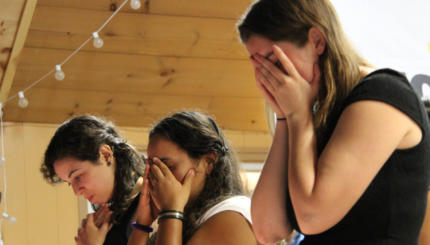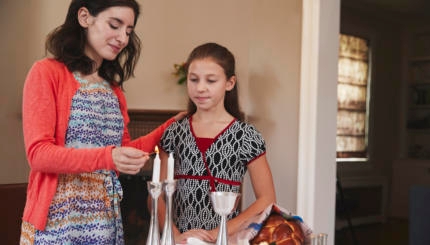Shabbat is ushered in every Friday night with the lighting of Sabbath candles, referred to in Yiddish as licht bentschen. In this article, we’ll answer practical questions about candle-lighting, look at the origin of the custom and give you all the information you need (including a video tutorial) to confidently light your Shabbat candles.
When are the candles lit?
It is traditional to light the Shabbat candles during the 18 minute window right before sundown on Friday, which marks the beginning of Shabbat. Some cities have a tradition of offering a larger window for candle-lighting, most notably Jerusalem whose window begins 40 minutes before sundown. (In Jerusalem, a siren that can be heard throughout the city is blown at this time on late Friday afternoon to alert citizens that candle-lighting time is upon them.) The earliest one may light Shabbat candles is 75 minutes before sundown.
After sundown, whether candles have been lit or not, Shabbat has begun and one may not kindle a flame. The timing of this window of course varies from location to location and throughout the year. There are many online tools to look up the Shabbat candle-lighting time in your area this week.
Are any candles acceptable?
Shabbat candles must burn at least until you recite Hamotzi, the blessing over bread, and some sources say that they should burn for two to three hours. For this reason, birthday candles and Hanukkah candles, which burn down quickly, are not recommended. There are specially-made Shabbat candles that will fit in a regular-sized taper holder but are shorter than taper candles (and therefore will not burn all night), but a regular tea light will also work perfectly well. Many people choose neronim, candles in glass cups, that look especially beautiful and are a way to perform hiddur mitzvah, beautifying the commandment of lighting Shabbat candles. For the same reason, if you have a beautiful pair of candlesticks, this the time to use them. It is customary to light white candles, though this is not a hard and fast rule.

Help us keep Jewish knowledge accessible to millions of people around the world.
Your donation to My Jewish Learning fuels endless journeys of Jewish discovery. With your help, My Jewish Learning can continue to provide nonstop opportunities for learning, connection and growth.
How many candles?
It is traditional to light a minimum of two candles in each household. Indeed, the pair of Shabbat candles is one of the most iconic images of the holiday. Many reasons are given for the number two. Some say that it indicates the candles are special — holding a purpose one candle alone cannot. Some say that it represents the two instances of the commandment of keeping Shabbat given in the Torah, one found in Exodus 20:8 that says “Zachor (remember) the Sabbath,” and one found in Deuteronomy 5:12 that says “Shamor (keep) the Sabbath.” Others hold that the number two underlies the two major themes of Shabbat: creation and revelation.
However, many households have a tradition of lighting more candles, often one for each member of the household.
Who lights the candles?
Traditionally, lighting Shabbat candles was the obligation of the woman of the household. In households with no adult woman, a man would take over the responsibility. In many contemporary egalitarian families, lighting candles may be done by any adult in the house — and it is often done by the family all together.
Should I blow out the candles before I go to bed?
No, Shabbat candles should not be extinguished but allowed to burn all the way down. If you anticipate that your candles will still be burning by the time you are ready to hit the hay, it is especially important to light them in a safe place, far from any paper, textiles or other flammable items. It is traditional not to move the candles after they are lit.
What is the origin of the candle-lighting?
The Torah says nothing about lighting candles to welcome Shabbat; the practice first appears in rabbinic literature. It seems to have originated as an extension of the practice of lighting a flame before Shabbat precisely because flames may not be kindled on the Sabbath. This flame was a source of light after the sun went down. However, the Shabbat candles evolved into an important part of the ritual and it became forbidden to use them for any practical purpose, including as light to read by (this is why some people do not move the candles after they are lit — to avoid the temptation of using them for some practical purpose).
The Talmud records that lighting Shabbat candles is a mitzvah, a commandment, but does not record a blessing attached to them. The first recorded instance of a blessing said for lighting the Shabbat candles is found in the Siddur of Rav Amram (9th c.), and it is the blessing we say today, apparently modeled on the blessing for lighting Hanukkah candles.
How do you light Shabbat candles?
Normally, in Jewish tradition, blessings are said before the act. We say Kiddush before drinking wine and Hamotzi before eating bread. However, because saying the blessing over the candles brings in Shabbat, and candles may not be lit on Shabbat, the order is in this case reversed: candles are lit first, and the blessing is recited afterward.
Instructions: First, light the candles. Then, many people wave their hands around the flame three times and then bring their hands over their eyes, keeping their eyes covered while they recite the blessing. Then, they open their eyes and experience the candles anew after the blessing is said (a substitute for the fact that the candles cannot actually be lit after the blessing is recited).
The Blessing:
בָּרוּך אַתָּה ה׳ אֱלֹהֵינוּ מֶלָךְ הָעוֹלָם אֲשֶׁר קִדְּשָׁנוּ בְּמִצְוֹתָיו וְצִוָנוּ לְהַדְלִיק נֵר שֶׁל שַׁבָּת
Barukh atah Adonai Eloheinu melekh ha’olam asher kid’shanu b’mitzvotav v’tzivanu l’hadlik ner shel Shabbat.
Blessed are You, Lord our God, Ruler of the Universe, who has sanctified us with commandments, and commanded us to light Shabbat candles.
Sign up for My Jewish Learning’s RECHARGE, a weekly email with a collection of Shabbat readings and more to enhance your day of rest experience.


